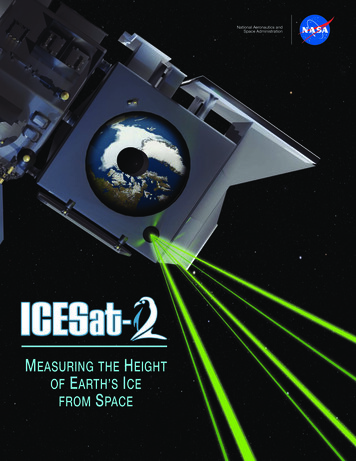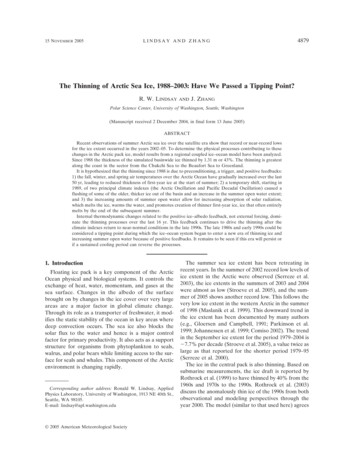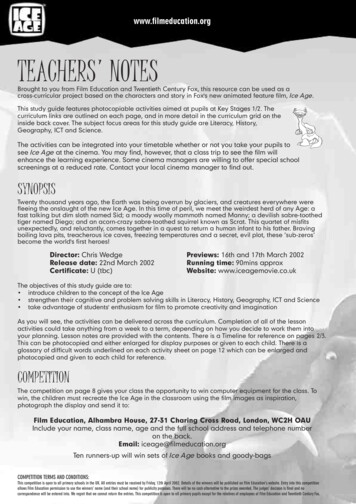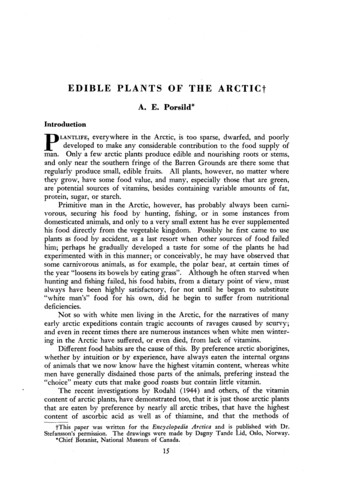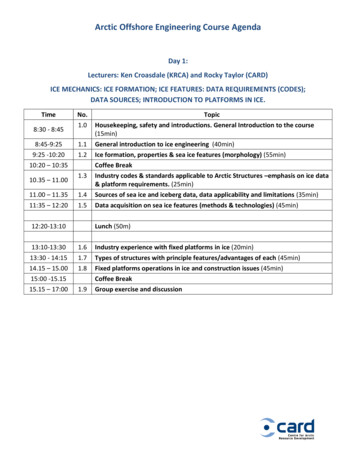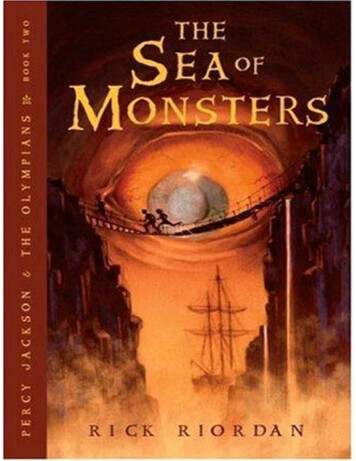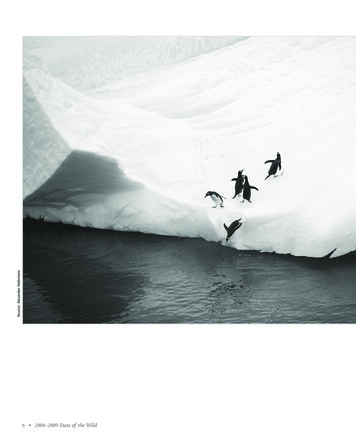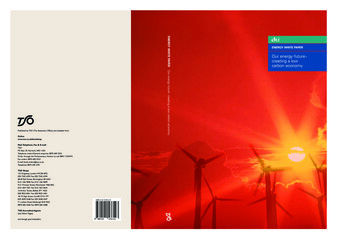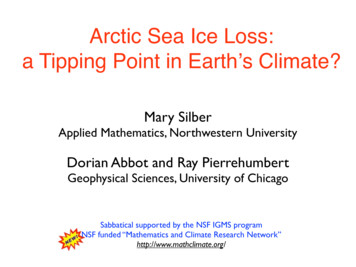
Transcription
Arctic Sea Ice Loss:a Tipping Point in Earthʼs Climate?Mary SilberApplied Mathematics, Northwestern UniversityDorian Abbot and Ray PierrehumbertGeophysical Sciences, University of ChicagoSabbatical supported by the NSF IGMS programNSF funded “Mathematics and Climate Research Network”http://www.mathclimate.org/
NASA Satellite ImagesSea Ice Minimum 1979:“Satellites See a Double-TexasSized Loss In Arctic Sea Ice”NASA 09.28.05Sea Ice Minimum 2005:
http://nsidc.org/data/seaice index/
Are there ‘tipping points’ for Arctic sea ice loss?Saddle-node bifurcationgreenhouse gases
Significance?Regional implications:Arctic wildlife and ecology; Arctic indigenous peoples and their economyGlobal political-economic implications:natural energy reserves, opening the Northwest passageClimate implications:global climate feedbacks involving the Arctic region“Sociological” implications:Arctic amplification of climate change -- is it a canary in the coal mine?
Are there ‘tipping points’ for Arctic sea ice loss?YES:“. have led to a tipping point in the public perceptionof the future melting of the Earth’s ice masses,there still exists a significant lack of scientific understandingof the cryospheric ‘tipping elements’.”
MethodsObservations:e.g. satellite images, field studies, proxy data for past climate reconstructions, etc.Global Climate Models (GCMs):e.g. state of the art codes that simulate everything at highest possible resolution,and considering different IPCC future emission scenarios.Intermediate Complexity Climate Models:e.g. computational coupled earth system models that don’t start from the primitiveequations. Run much faster than GCMs, but contain more parameterizations.Conceptual Models:e.g. simple mathematical models with feedbacks, included or not, in some fashion.
Tipping points in GCMs?Holland, Bitz and Tremblay, GRL (2006)
Tipping points in GCMs?
Conceptual Models(a.k.a. Energy Balance Models, Box Models,Toy Models.)some “classics”:Budyko 1969 / Sellers 1969ice-albedo feedbackNorth 1984Thorndike 1992.& more recently:Merryfield, Holland & Monahan 2008Eisenman & Wettlaufer 2009 sea ice thermodynamics
ice-albedo feedback:
EW09 0-D model: positive ice-albedo feedbackvs. stabilizing sea ice thermodynamicsFigure from:
The 0-d model(“EW09”: Eisenman & Wettlaufer, PNAS 2009)State variable E(t): average energy per unit surface area(relative to Arctic ocean mixed layer at the freezing point)E(t) Li hi (t) if E 0 (i.e. E ice thickness hi )Cs T (t)if E 0, (i.e. E mixed layer temp. T )Li latent heat of fusion of iceCs ocean heat capacity per unit surface areaAtmosphereSea ice/ocean mixed layer
EW09 results:(Eisenman & Wettlaufer, PNAS 2009)the role of sea ice thermodynamics: no summer tipping point?ice albedo feedback onlywith sea ice thermodynamicsTmaxTminseasonal ice statehminhmaxAgreenhouse gasesA
The 0-d model(after Eisenman & Wettlaufer, PNAS 2009)A(E) BT (E, t)α(E)Fsolar (t)AtmosphereSea ice/ocean mixed layerFsolar (t)Fsouthvice (E)FbottomdE [1 α(E)]Fsolar (t) Fbottom Fsouth vice (E) [A(E) BT (E, t)]dt
The 0-d model(after Eisenman & Wettlaufer, PNAS 2009)A(E) BT (E, t)α(E)Fsolar (t)Fsolar (t)AtmosphereSea ice/ocean mixed layerFsouthvice (E)FbottomdE [1 α(E)]Fsolar (t) Fbottom Fsouth vice (E) [A(E) BT (E, t)]dtconstants E (for E 0, otherwise 0)
“Top of the Atmosphere albedo”Figure from Abbot, Silber,Pierrehumbert 2011(CAM GCM)(NCEP Observation)open ocean sea icedE [1 α(E)]Fsolar (t) Fbottom Fsouth vice (E) [A(E) BT (E, t)]dt
The 0-d model(after Eisenman & Wettlaufer, PNAS 2009)Incoming Solar Radiation:Positive Ice Albedo feedbackAlbedoα(E)InsolationFsolar (t)α(E)Fsolar (t)dE [1 α(E)]Fsolar (t) Fbottom Fsouth vice (E) [A(E) BT (E, t)]dt
“Outgoing long wave radiation”( GCM)Figure from Abbot, Silber,Pierrehumbert 2011( Observation)dE [1 α(E)]Fsolar (t) Fbottom Fsouth vice (E) [A(E) BT (E, t)]dt
“Outgoing long wave radiation” AcAiA(E) Ac“Long-wave cloud feedback”Ai A0 AghgdE [1 α(E)]Fsolar (t) Fbottom Fsouth vice (E) [A(E) BT (E, t)]dt
The 0-d model(after Eisenman & Wettlaufer, PNAS 2009)E(t) Li hi (t) if E 0 (i.e. E ice thickness hi )Cs T (t)if E 0, (i.e. E mixed layer temp. T )Sea-ice thermodynamics (E 0)Ttop TT khiTB 0FbottomFtop k hTiTLi dhdtif T 0 (Ftop 0)if T 0 (Ftop 0)outinFtop Fsurf Fsurf aceace [A BT Fsouth ] [1 α]FsolardE [1 α(E)]Fsolar (t) Fbottom Fsouth vice (E) [A(E) BT (E, t)]dt
“cloud feedbacks”: no summer tipping point?Figure from Abbot, Silber,Pierrehumbert 2011Reduced OLRdue to cloudsReduced albedo contrastAlbedo α(E)A(E)αi Ac αcαo haE haE
cf. EW09 resultsseasonal ice
seasonal ice-free states:existence boundaryα(E)αi αcαo haE
Some analysis:determining existence conditions for seasonally ice-free statesApproximation: piecewise constant α(E) and A(E)A(E)Albedoα(E)iceoceanEiceoceanEdE [1 α(E)]Fsolar (t) Fbottom Fsouth vice (E) [A(E) BT (E, t)]dt
Existence conditions for seasonally ice-free statesdE [1 α(E)]Fsolar (t) Fbottom Fsouth vice (E) [A(E) BT (E, t)]dtFsolar (t)E(t)oceanicehi (t)ice-freephaseicephaset 1t 0t tm t tft tm 1Periodic solutions: fixed points of appropriate Poincaré map (P Pi Po )PoPiE 0E 0(t tm , E 0) (t tf , E 0) (t tm 1, E 0) . . . ad inf initum
Existence conditions for seasonally ice-free statesPeriodic solutions: fixed points of appropriate Poincaré map (P Pi Po )PoPiE 0E 0(t tm , E 0) (t tf , E 0) (t tm 1, E 0) . . . ad inf initumPo (E 0; tm , tf , A Ac , αo αc ) 0Pi (E 0; tm , tf , A, αi ) 0αiAlbedoA(E)α(E) Acαo αcEE
BEdE [1 αo αc ]Fsolar (t) [Fbottom Fsouth A Ac ]dtCsFbottom Fsouth A Ac Constant 1 αo αc
Future direction:More systematic approaches to parameterizationsA(E) BT (E)α(E)Fsolar (t)Fsolar (t)AtmosphereSea ice/ocean mixed layerFsouthvice (E)Fbottome.g. if E average surface energy density in the Arctic region, then?dE ? [1 α(E)]Fsolar (t) Fbottom Fsouth vice (E) [A(E) BT (E, t)]dt
Summary Slide (1 of 6 closing slides)We performed a bifurcation analysis on a variation of theEisenman and Wettlaufer 2009 energy balance model ofArctic sea ice loss.Three distinct parameter regimes were found, which varyin the number and types of tipping points.Results are sensitive to how the albedo is smoothed overthe transition from an ice-covered to an ice-free Arctic.This points to some of the challenges inherent inmathematical modeling of climate.
Questions I didn’t answer:What is a tipping point? And are we close to one for Arcticsea ice loss? If so, how bad will it be?Could we tell in advance of crossing one? And, if so, whatshould we be measuring to know its proximity?
Arctic sea ice loss:the tip of the iceberg for climate tipping points“Policy-Relevant Tipping Elements”?
Future directions:What is a good signature of a bifurcation in a GCM?Holland, Bitz and Tremblay,vs.Abbot, Silber & Pierrehumbert,see, for example,Held and Kleinen, GRL 2004Livina and Lenton, GRL 2007Dakos, et al. PNAS 2008Thompson & Sieber 2010/2011 papers(Also, works of H.A. Dijkstra and collaborators)
Future directions:What is a good signature of a bifurcation w.r.t. sea ice?vs.
Disclaimer:tipping points, not always a pping”Ashwin, Wieczorek, Vitolo, Cox (2011)GRL (2010)
the role of sea ice thermodynamics: no summer tipping point? (Eisenman & Wettlaufer, PNAS 2009) T max T min h min h max A ice albedo feedback only A with sea ice thermodynamics seasonal ice state greenhouse gases. Atmosphere Sea ice/ocean mixed layer F bottom F south F solar (t) v ice (E ) α(E)F solar (t)
